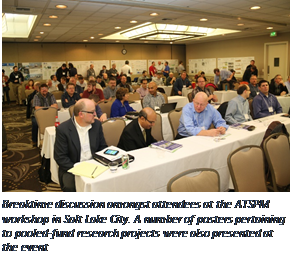Salt Lake City Peer Exchange 2016 By Steven Lavrenz, PhD, EIT
First of all, for those who attended the Automated Traffic Signal Performance Measures (ATSPMs) workshop, or for those simply interested in continuing the conversation on traffic signal performance measures, I encourage you to participate in NOCoE’s discussion forums. There are several threads that have been started on ATSPMs already, and we would love to see them grow. Please visit the NOCoE website at transportationops.org and choose “Discussion” from the homepage to register and continue the dialogue!
 On January 26th & 27th, I had the opportunity to attend the ATSPMs workshop in Salt Lake City, Utah. This was a peer exchange sponsored by the Federal Highway Pooled Fund Study for Traffic Signal Systems Operations and Maintenance (of which Purdue University, UDOT, and INDOT are leading partners), along with AASHTO and the NOCoE. The experience was incredible! I'm a relative newbie in the traffic signals community, and I was astonished at the level of engagement and the nature of discourse coming from the nearly 170 attendees.
On January 26th & 27th, I had the opportunity to attend the ATSPMs workshop in Salt Lake City, Utah. This was a peer exchange sponsored by the Federal Highway Pooled Fund Study for Traffic Signal Systems Operations and Maintenance (of which Purdue University, UDOT, and INDOT are leading partners), along with AASHTO and the NOCoE. The experience was incredible! I'm a relative newbie in the traffic signals community, and I was astonished at the level of engagement and the nature of discourse coming from the nearly 170 attendees.
A recurring theme in discussion was how to carry on the momentum of this event in the promotion and development of ATSPMs. Along those lines, I wanted to share some of my personal takeaways from the peer exchange, including my thoughts on some of the issues we as a TSM&O community should focus on in the months ahead, as they pertain to traffic signal operations and technology development. As part of this, I have included some questions that I hope readers will take time to reflect on. I have listed the same questions in a thread on our NOCoE discussion forums, so if you have a minute, please weigh in online with your own opinions.
Engagement of hardware manufacturers and technology vendors: This is an item that was brought up repeatedly throughout the workshop, and was covered quite well in the panel session that took place on the second day. For ATSPMs to succeed, the private sector, including OEMs and their sales vendors, must be an integral part of the conversation. Historically, the onus has been on the university and public agency partners to not only develop the ideas for ATSPMs, but also figure out how to integrate them into existing hardware setups and decision-making tools. There is a huge opportunity (both financially, and in the spirit of knowledge advancement) for the private sector to leverage the growth and development of ATSPMs to develop new products and value-added services for their customers.
What role (or balance of roles) do you think that public agencies vs. private sector vs. research institutions should play in the development of ATSPMs?
Continued SPM experimentation and collaboration: The current growth and popularity of ATSPMs has been through a collaborative effort by numerous groups, including Purdue University and the Pooled Fund Study partners, UDOT, INDOT, and the FHWA. At the same time, many new agencies and partners are stepping in to share the burden of SPM development, and to explore alternative uses for high-resolution data technology. It is imperative that we continue to experiment with and refine the development of existing SPMs, such that they can more accurately represent the needs and objectives or a variety of agencies.
Along those lines, where do you see some of the largest gaps right now in terms of SPM development?
How do we ensure that new developments in ATSPMs continue to be shared amongst all public and private agencies?
Championing for continued federal funding and national standards: The FHWA and its partner organizations have been a great champion for the initiatives related to ATSPMs, including the recently-concluded ATSPM workshop. While it is easy to sell individual agencies and vendors on the benefits of ATSPMs, the conversation must move to a national policy level to facilitate widespread adoption and development. The recently-signed FAST Act should help in this effort, with its continued focus on data-driven decision making and performance measurement, similar to MAP21. Furthermore, efforts such as the FHWA's "Every Day Counts" initiative have the potential to fast track higher funding levels for ATSPM deployment.
Where do you see the future of ATSPMs heading, especially in the context of national pushes for other technology developments, such as autonomous & connected vehicles?
Is the time right for the development of a national ATSPM set of standards?
These topics are by no means meant to be a comprehensive list of development needs, and indeed, there are many conversations that occurred at the workshop which I was not privy to, along with those dialogues happening outside of this single event. That said, I hope these questions serve as a springboard for further discourse in the realm of ATSPMs.
There are a host of needs that must be met as we continue to push forward in the development of ATSPMs as a viable decision-making tool for agencies. These include opportunities for additional research, and integration with the various traffic operations theories that have guided practitioners for the last 60+ years. Others include logistical challenges, such as how to develop contract language for an agency to spec out the development of an ATSPM system. When I look at these opportunities for growth and development, as a researcher and an engineer, I can’t help but think that it’s an exciting time to be involved with traffic signals!